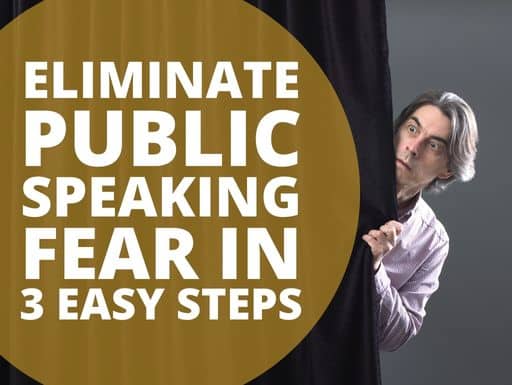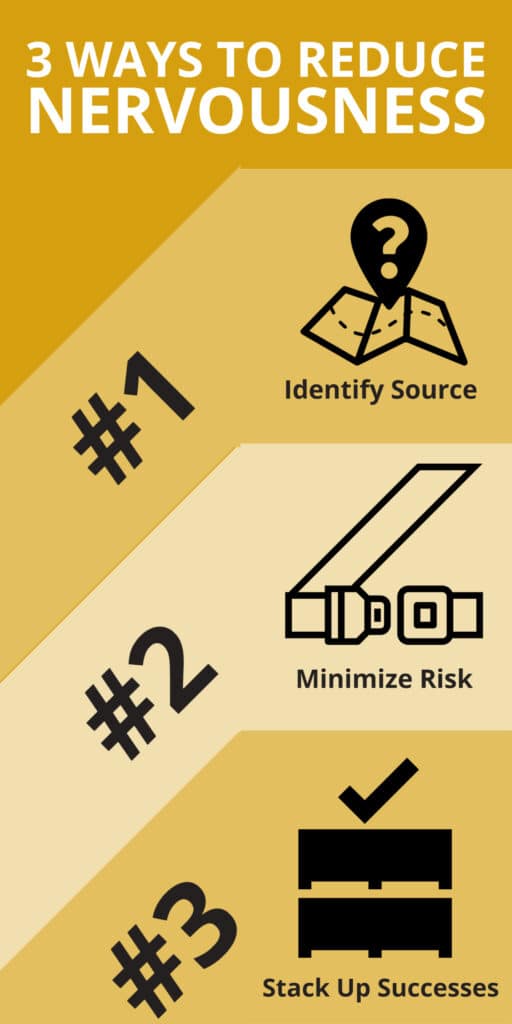
The process is really simple. In fact, anyone can reduce public speaking anxiety if they follow this process. Over the last 20 years, our great public speaking class instructors have perfected the best ways to reduce anxiety symptoms. And we have organized the process into three simple steps. The process works every single time!
In this session, we explain this simple process. However, if you looking for public speaking tips, see 10 Ways to Eliminate the Fear of Public Speaking. In that episode, we show you how to lower your heart rate, take deep breaths, and eight other ways to calm speech anxiety. This session is a little different, though. We are NOT going to give you a bunch of tips about how to reduce stage fright. Instead, we will show you how to become a good public speaker, so the nervousness goes away altogether.
By the way, if you want details about the technical process that we use to reduce public speaking fear, click here.
The Three Easy Steps to Eliminate Public Speaking Fear Explained

surveys show that up to 80% of the general population has some type of presentation fear. (See Public Speaking Fear Statistics.)
If you think this isn’t true, the next time you stand up in front of a group of people, say the following. “One of you is going to be our guest speaker for this meeting.” Then, just watch the audience’s reactions. The flight response will quickly kick in. Watch how fast your audience members have an important phone call to make.
The good news is that this nervousness is the most common form of anxiety. All of the best public speakers in the world didn’t start out as one of the best speakers. They were nervous speaking in front of others, just like everyone else. Eventually, though, they conquered that fear. You can too.
Do These Three Things to Eliminate Speech Anxiety.
- Identify Where the Public Speaking Fear is Coming From. If you know where the fear is coming from, you can mitigate the chances of it appearing.
- Minimize the Risk of Failure When You Present in Front of an Audience. Once you know where the fear comes from, look for ways to minimize the risk when those situations occur.
- Stack Up a Series of Public Speaking Successes. When you practice the skill and have success, your confidence will grow. So, the faster you can have a series of successes, the faster your confidence will grow.
1) The First Step Is to Identify Where the Public Speaking Fear is Coming From.
Fear or nervousness, most often, comes from situations where there is a risk of loss or danger. The more dramatic the risk, the more nervousness you will experience. This nervousness is normal, though. In fact, we experience it just about every time that we try something new.
For instance, the first time you ever drove a car, you were most likely nervous. You may have started learning in a parking lot with cones. However, after you had a few successes, your nervousness likely decreased somewhat. Next, you likely started driving in a somewhat deserted neighborhood. Then a busier street. Finally, you likely moved to a highway.
At each new stage, you felt the nervousness again. However, by the time you started driving on a busy highway, driving in a parking lot was second nature. The point is that the fear of public speaking is a natural part of the growing process. It lets you know how far you have come in the process.
Public speaking fear is like riding a roller coaster for the first time or going to a haunted house as a kid. Each of these situations is nerve-racking the first time. However, after you experience them a few times, you realize the fear — although very real the first time — is often highly exaggerated.
So, the first thing you want to do is discover where your nervousness is coming from. Do you get more nervous in front of large audiences or smaller groups? If your boss is in the room, does that cause you to have more or less anxiety? Do you get more nervous in a small group because you are afraid you will get questions?
The answers to each of these questions will help you create a plan to help you perform better in your next public speaking event. Schedule more speeches in front of larger groups, or smaller groups, or invite your boss to hear you speak. Then, prepare for those speeches differently.
2) Minimize the Risk of Failure When You Present in Front of a Group.
Once you know where the fear comes from, the next step is to look for ways to minimize the risk when those situations occur. In this step, you can start small. For instance, if you typically don’t speak up in a staff meeting, then look for a way to voice an opinion in the next one.
Or, you could volunteer to speak at a social club like Rotary or Kiwanis. These clubs look for guest speakers every week. The risk is low for this type of speech because you can’t get fired, lose a big contract, or even be embarrassed speaking in front of people that you know. If you bomb the speech, who cares? But if you perform well, you build confidence. (For additional details, see Great Venues to Practice Speaking in Front of a Group,
Another great way to practice is to ask questions when other speakers present.
Each of these situations will allow you to speak in front of groups more. They also each have a relatively low risk of failure. For instance, staff meetings are pretty forgetful, for the most part. Once everyone leaves and returns to work, is a distant memory. After a few more meetings, no one remembers every detail of the staff meeting that was conducted weeks ago.
As you have a series of tiny successes, your confidence will begin to grow. In addition, as you speak more and more, look for speaking opportunities that are more challenging than the last. Just as we started in the parking lot driving, if we stay in that parking lot for the rest of our lives, we won’t really accomplish a lot.
One of the reasons that the Fearless Presentations ® class works so well is that the instructors will assign very simple presentations at the beginning of class. Then, we coach participants before and during each speech so they can’t fail. Basically, we lower the risk of failure dramatically. We also reinforce the success by giving positive feedback.
Then, little by little, we increase the difficulty in an easy-to-follow, step-by-step manner. This allows each student to grow in confidence with each new presentation.
3) Stack Up a Series of Public Speaking Successes.
When you practice public speaking skills and have a success, your confidence will grow. When you have what you perceive to be a failure, your nervousness will grow. (Your confidence will shrink.) So it is important to stack up a series of successes in a short period of time. That way, if something negative does happen, it doesn’t destroy our confidence.
The best way to do this is to look for opportunities to speak that we might have passed up in the past. If those opportunities don’t present themselves, then make opportunities for yourself. This process is like practicing in a sport. If a kid only does batting practice once a week, it is hard to build up momentum. However, if the kid practices at home just a couple of extra times per week, the kid’s batting average will increase dramatically. The point is that you can’t gain confidence if you never come up to bat.
By the way, the Covid pandemic increased caused a major problem here. The average person spent a year (or two) without presenting in front of a room at all. Now that these speaking opportunities are increasing, the nervousness is also increasing. If it has been a long time since you presented in front of an audience, it is important that you get back on the horse. Look for opportunities to speak. Get more presentation practice. And, in the process, stack up a series of successes. If you do this, you can eliminate public speaking fear forever!
The Simplest Way to Reduce Presentation Nervousness.
If you are looking for a way to eliminate your public speaking fear quickly, register for a 2-day public speaking class in your area. You will experience the power of these three simple steps first-hand. We’ve trained over 20,000 people in the last 18 years, and we’ve never had even a single person fail to increase confidence dramatically. The process works. It will work for you as well!

